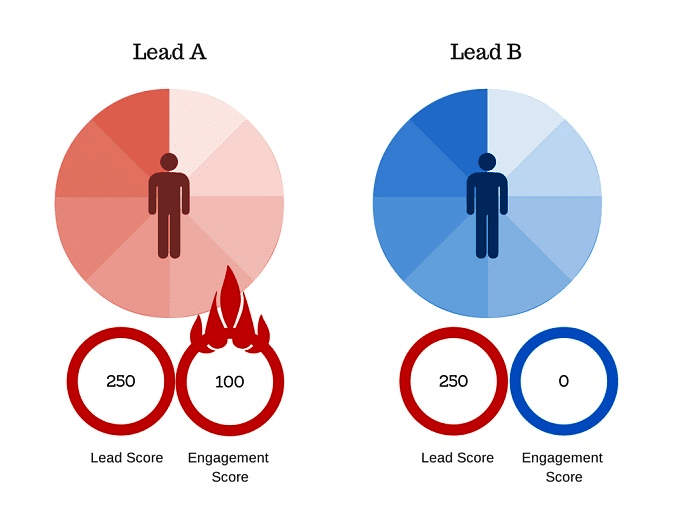In the context of achieving more sales, all companies strive to generate more leads. So let’s check out everything about the Lead Scoring Model article. The leads are also known as prospects. These are people with high potential to purchase products or services. If someone is into buying personalised watch straps, they are a leader for a new company that sells handmade watch straps. Any sales contract or prospective customer is labelled as a lead.
The process of lead generation is focused on enhancing the interest of potential customers in the products or services the company sells. For this purpose, the marketing team develops a plan to boost brand awareness through an online promotional campaign, phone calls, personal referrals, events, or any other marketing technique. Now let’s get to know more about this Lead Scoring Model guide.
(Guides) Everything about on Lead Scoring Model
But what’s the exact potential that each lead has for buying? That’s where the lead scoring concept fits into the equation.
What is a Lead Scoring Model?
Lead scoring is a precise system for evaluating the readiness of a lead to make the purchase. An organisation may evaluate the leads by using descriptive terms, like unlikely, potential, or most likely. Some companies develop a Lead Scoring Model that ranks leads by grades: A, B, C, and so on. Others assign points.
The lead scoring model is a precise system of assigning values to leads, with the purpose of fitting everyone in the right category.
The point of this process is not focusing on specific leads and neglecting others. It’s about proper categorisation, so the marketing team can decide who needs more nurturing and who’s ready to proceed with a purchase. With such knowledge, the team can enhance the communication between the company and its leads. Through proper messages and responses, the rate of conversions will grow.
Why Does a Business Need a Lead Scoring Model?
A lead scoring model is not mandatory for every business. Still, it’s beneficial because it helps the marketing team to prioritise leads, identify conversion potential close sales, and improve the overall sales process. If a company has a sales team that needs more structure, the lead scoring model is an absolute must.
These are the main benefits of a structured lead scoring system:
- If the sales team has more leads than they can follow up with, proper categorisation helps with their campaign. By giving a score to each lead, they know when and how to act towards the purchase or another stage of the sales funnel.
- Communication with prospects becomes more relevant. This lead scoring model helps you understand their current attitude towards your business.
- Ultimately, an efficient lead scoring model improves the overall sales process.
What Is Data Used to Build the Lead Scoring Model?
Each company adjusts the lead scoring model according to its needs. It uses various types of data to develop a system for assigning scores. The leads may be scored on various attributes, based on the way they engaged with the brand on social media, the way they interacted with the website, the information they submitted, and more.
In general, these are the types of data that most lead scoring model use:
-
Demographics
To give a precise score for demographics (or for any other factor that matters), the company must first analyse its market and develop a target customer persona. If the sales team notices that employees in the medical industry tend to buy their products the most, they will add more points to a lead from that industry.
These are the demographics you can consider scoring:
- Industry
- Income
- Role
- Size of Company
- Experience in role and industry
- Hobbies
-
Prospect’s Behavior
To identify demographic criteria, the sales team will analyse the market. But to identify scoring factors on the behaviour of their leads, they will conduct an analysis on the inside. They need to see how leads interact with the business. Google Analytics or SEO platform can help you.
These are some of the behaviours you can score:
- How the lead interacted with the lead magnet (you’ll assign different scores for those who viewed it, requested it by email, and shared it via social media)
- Their interaction with customer support
- The number of pages they viewed on the website (you’ll add points for each page)
- The frequency of visits to the website
- The sales emails they open
- The links they open from sales email messages
The list doesn’t stop there. You’ll add many more points, depending on the nature of your business.
Someone who asks questions via live chat at your website downloaded a white paper, visited multiple pages, and attended a webinar will have a high lead score. If you add points from demographics, the score will be even higher. In that case, the sales team knows that this lead is ready for conversion so that it can act with a proper incentive.
Tips: How to Build a Lead Scoring Model
To make it as simple as possible, you can develop a lead scoring model that uses a scale from 0 to 100. You’ll identify the data you’ll measure, and you’ll assign a score for each factor.
Let’s take the example we used before a business that targets employees from the medical industry. Here are a few examples of factors we can include in the scoring system:
- Followed a link from email (10 points)
- Doctor (10 points)
- 10+ years of work experience (5 points)
- Visited a page on the website (10 points)
- Visited more than three pages in a single session (20 points)
- Checked the prices (5 points)
- Interacted with customer support (5 points)
- Signed up for a webinar (15 points)
- Submitted a guest blog post (10 points)
- Over $100K in annual income (10 points)
Altogether, these factors make up to 100 points. Not all leads will have such a high score.
You’ll need to add negative points as well. For example:
- Unemployed (-10 points)
- Moves email message to spam (-20 points)
- Lives in a country you can’t ship to (-20 points)
Once you have your system, you can categorise the leads:
- Those with a score of 70-100 are most likely to convert. You’ll assign them to the category A. All they need is the final trigger, such as a time-sensitive discount code or any other special offer. In most cases, these leads will convert without serious pushing, since they are very interested in the offer.
- Those with a score of 50-70 need slightly more nurturing. You’ll assign them to the category B. For this category, you may offer a free eBook or another type of educational content. You want them to learn more about your business.
- For the leads with a score lower than 50, you’ll create the category C. This is the category that needs more work in the long run. You can send weekly or biweekly email messages, offer greater discounts and make sure to provide more educational content. As long as they stay subscribed to your email list, you may still consider them as prospects.
There’s No Perfect Lead Scoring Model, So Test Along the Way
In theory, your Lead Scoring Model will work perfectly well. But when you implement it in practice, things get more complicated. Once you start working on this lead scoring model, it’s important to monitor how it works. Observe the results the team achieves on a monthly basis and experiment with a few changes along the way.
Over time, you’ll develop a lead scoring model that works for your business.
Conclusion:
So this is all about the Lead Scoring Model article guide. Hope you like this Lead Scoring Model from here now.
Hope you enjoy checking this type of Lead Scoring Model content. If you enjoy reading the Lead Scoring Model then please do share Lead Scoring Model with others as well also.
More information:
- Zhou, Z., Zhang, Q., Su, C., & Zhou, N. (2012). How do brand communities generate brand relationships? Intermediate mechanisms. Journal of Business Research
- Morgan, R. M. & Hunt, S. D. (1994). The Commitment-Trust Theory of Relationship Marketing. American Marketing Association, Journal of Marketing
- Jarvinen, J. & Taiminen, H. (2015). Harnessing marketing automation for B2B content marketing. Industrial Marketing Management.















![[Buy Now] ALLDOCUBE Freer X9 Review Tablet PC “Offer” Price (Buying Guide) Freer X9](https://www.techinpost.com/wp-content/uploads/2018/01/83e7d39bgy1fjux8u2zlbj20m80et4hn-324x235.jpg)



